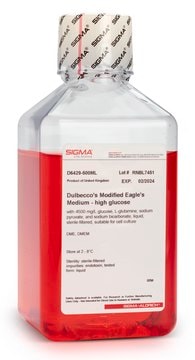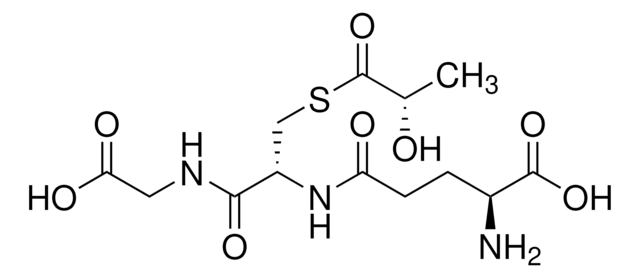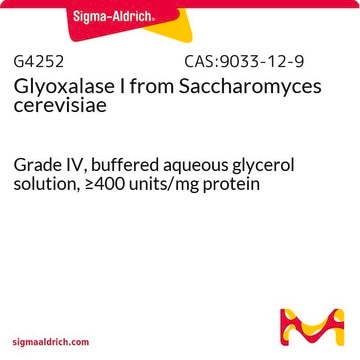Products may be shipped at a different temperature than the recommended long-term storage temperature. If the product quality is sensitive to short-term exposure to conditions other than the recommended long-term storage, it will be shipped on wet or dry-ice. If the product quality is NOT affected by short-term exposure to conditions other than the recommended long-term storage, it will be shipped at ambient temperature. As shipping routes are configured for minimum transit times, shipping at ambient temperature helps control shipping costs for our customers. For more information, please refer to the Storage and Transport Conditions document: https://www.sigmaaldrich.com/deepweb/assets/sigmaaldrich/marketing/global/documents/316/622/storage-transport-conditions-mk.pdf
Wichtige Dokumente
M0252
Methylglyoxal -Lösung
~40% in H2O
Synonym(e):
Acetylformaldehyd, Pyruvaldehyd
About This Item
Empfohlene Produkte
Form
liquid
Qualitätsniveau
Konzentration
~40% (enzymatic)
~40% in H2O
Dichte
1.17 g/mL at 25 °C (lit.)
Lagertemp.
2-8°C
SMILES String
[H]C(=O)C(C)=O
InChI
1S/C3H4O2/c1-3(5)2-4/h2H,1H3
InChIKey
AIJULSRZWUXGPQ-UHFFFAOYSA-N
Suchen Sie nach ähnlichen Produkten? Aufrufen Leitfaden zum Produktvergleich
Verwandte Kategorien
Allgemeine Beschreibung
Anwendung
- zur Bewertung der Glyoxalase 1-Enzymaktivität (GLO1)[3][4]
- als Advanced Glycation End-Bildungsmittel (AGE) zur Herstellung von Albumin in vitro[5]
- zur Regulierung von angstähnlichem Verhalten bei Mäusen[6]
- zur Einleitung von peritonealer Fibrose bei Ratten[7]
- zur Untersuchung der chromatografischen Retentionseigenschaften von organischen Chemikalien und Metall-DNA-Addukten[8]
- zur intraplanaren Injektion bei Mäusen zur Untersuchung der peripheren und zentralen Komponenten des Methylglyoxal(MG)-Transient receptor potential Ankyrin 1 (TRPA1)-Adenylycyclase 1 Isoform (AC1)-Wegs[1]
Signalwort
Danger
H-Sätze
Gefahreneinstufungen
Eye Dam. 1 - Met. Corr. 1 - Muta. 2 - Skin Sens. 1
Lagerklassenschlüssel
8A - Combustible corrosive hazardous materials
WGK
WGK 1
Flammpunkt (°F)
Not applicable
Flammpunkt (°C)
Not applicable
Persönliche Schutzausrüstung
Eyeshields, Faceshields, Gloves, type ABEK (EN14387) respirator filter
Hier finden Sie alle aktuellen Versionen:
Besitzen Sie dieses Produkt bereits?
In der Dokumentenbibliothek finden Sie die Dokumentation zu den Produkten, die Sie kürzlich erworben haben.
Kunden haben sich ebenfalls angesehen
Artikel
High-Performance Thin-Layer chromatography (HPTLC) quantification of methylglyoxal (MGO) in complex and matrix rich manuka honey offering quick sample preparation, high-matrix tolerance, and high-throughput.
-
How is shipping temperature determined? And how is it related to the product storage temperature?
1 answer-
Helpful?
-
-
How can I determine the shelf life / expiration / retest date of this product?
1 answer-
If this product has an expiration or retest date, it will be shown on the Certificate of Analysis (COA, CofA). If there is no retest or expiration date listed on the product's COA, we do not have suitable stability data to determine a shelf life. For these products, the only date on the COA will be the release date; a retest, expiration, or use-by-date will not be displayed.
For all products, we recommend handling per defined conditions as printed in our product literature and website product descriptions. We recommend that products should be routinely inspected by customers to ensure they perform as expected.
For products without retest or expiration dates, our standard warranty of 1 year from the date of shipment is applicable.
For more information, please refer to the Product Dating Information document: https://www.sigmaaldrich.com/deepweb/assets/sigmaaldrich/marketing/global/documents/449/386/product-dating-information-mk.pdfHelpful?
-
-
40%ということですが、25ml中10g程度のMGOが含まれるという理解でよろしいでしょうか。
1 answer-
The 40% approximation is mass/mass. In 25 grams of product, there will be 10 grams of methylglyoxal. The density of this preparation is 1.17 g/mL at 25 °C.
Helpful?
-
-
What are the mass and concentration of 25ML methylglyoxal solution?
1 answer-
As per the webpage of M0252: https://www.sigmaaldrich.com/product/sigma/m0252
The density is 1.17 g/mL at 25 °C (lit.). So the mass of 25 mL = 1.17 x 25 =29.25 g.
The concentration = Density x w/w% x 1000 / Molecular Weight = 1.17 x 40% x 1000 / 72.06 = 6.49 mol/L.Helpful?
-
-
Hi I am using this chemical for my research, could you please tell me the molarity of this solution?
1 answer-
The molarity of the Methylglyoxal solution is approximately 6.49 M. This value may be calculated as follows:
Molarity = Density x w/w% x 1000 / Mw = 1.17 x 40% x 1000 / 72.06 = 6.49 mol/LHelpful?
-
-
How to dilute methylglyoxal? What is the stock concentration?
1 answer-
The stock concentration will range from 4.89 M to 8.11 M, depending on the percent methylglyoxal - the specification ranges from 30 % to 50 %. The molecular weight of methylglyoxal is 72.06 g/mol.
Using the catalog density of 1.17 g/mL at 25 °C, the molarity would calculate to 6.49 molar for a 40 % solution (1,170 g/L × 0.40 = 468 g/L; 468 g/L divided by 72.06 = 6.49 M).
The actual % concentration is reported on the lot-specific Certificate of Analysis.
See the link below to access a specific lot or to review a sample Certificate:
https://www.sigmaaldrich.com/US/en/product/sigma/m0252#product-documentationThe solution is aqueous and may be further diluted in more water. If diluting with an organic solvent is preferred, ether or alcohols (i.e. ethanol, methanol) are also miscible with water.
Helpful?
-
-
Is the listed density, 1.17 g/ml, for the entire solution i.e. the Methylglyoxal in water or just the Methylglyoxal compound?
1 answer-
The density is 1.17 g/mL for the prepared solution.
Helpful?
-
Active Filters
Unser Team von Wissenschaftlern verfügt über Erfahrung in allen Forschungsbereichen einschließlich Life Science, Materialwissenschaften, chemischer Synthese, Chromatographie, Analytik und vielen mehr..
Setzen Sie sich mit dem technischen Dienst in Verbindung.
















